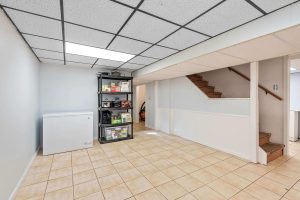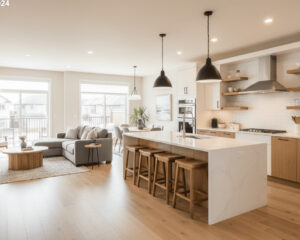Making your renovation greener isn’t just about feel-good choices. It’s about smarter decisions that reduce energy use, improve indoor comfort, and extend the life of the work you pay for. For Edmonton homeowners, where cold winters and warm summers shape choices, a green home renovation can mean better insulation, quieter heating and cooling, healthier indoor air, and fewer surprises down the road.
This guide explains what “green home renovation” means in practice, how to prioritise upgrades for maximum benefit, where to look for local and federal support, and how to work with a contractor who respects both performance and permits. I’ll include local examples, practical checklists, and the few programs and data points homeowners should know about before they start. When helpful, I’ll note how Steadfast Constructions Ltd. supports eco-minded renovations across Edmonton.
What a green renovation actually looks like
“Green” is a broad word. In a house, it usually means one or more of the following:
- Reducing energy demand (better insulation, air-sealing).
- Switching to cleaner systems (heat pumps, high-efficiency furnaces).
- Improving ventilation and indoor air quality (balanced mechanical ventilation with heat recovery).
- Choosing durable, low-impact materials (low-VOC finishes, responsibly sourced wood).
- Planning for longevity and flexibility (modular layouts, easy-to-service systems).
Those outcomes work together. Improving insulation without addressing ventilation can create condensation or poor air quality. Upgrading systems without fixing air leaks wastes the benefit of the equipment. Good green home renovation ties measures together and sequences them so each upgrade supports the others.
Start with a short energy-first assessment.
Before you pick fixtures or tile, get a quick assessment that focuses on the building envelope and mechanical systems. For basement conversions or whole-house renovations, this step is especially valuable because basements often show the home’s moisture and heat performance clearly.
What to check in an assessment
- Air leakage and drafty spots around windows, doors, and rim joists.
- Insulation levels in walls, attic, and basement perimeter.
- Condition of windows and exterior doors.
- Existing heating system type and ductwork condition.
- Ventilation strategy and combustion appliance safety.
A certified energy advisor or an experienced contractor can do a short, practical review and give you a ranked list: “Fix this first, consider that next.” If you’re considering government programs or incentives, this assessment is often required to qualify. The earlier you do it, the fewer surprises later.
Insulation and air sealing come first.
If there’s one single rule for green renovations, it’s this: tighten the house first, then tackle the systems. In Edmonton’s climate, that means focusing on continuous insulation, attention to the attic and basement, and proper air sealing.
Key moves
- Insulate and air-seal the attic and top plates to stop warm air escaping in winter.
- Seal rim joists and service penetrations in the basement; add insulation at the foundation wall or interior basement perimeter where appropriate.
- Use continuous insulation strategies where possible to reduce thermal bridging.
These measures reduce load on heating systems, improve comfort, and often reduce noise. They also make future system upgrades, like installing a heat pump, more effective because the house needs less heating or cooling to maintain comfort.
Choose efficient heating and cooling systems
Heat pumps, both air-source and ground-source, are now commonly recommended for Edmonton homes because they deliver heating and cooling efficiently when paired with a well-tuned envelope. If you’re renovating a basement or replacing a furnace, consider how a heat pump would perform once the house is tightened. Work with a contractor who will model system sizing rather than oversizing equipment “just in case.”
Other considerations
- Improve ductwork and reduce leaks if you keep a forced-air system.
- Consider hybrid systems where a gas furnace remains, but a heat pump handles most heating loads.
- Add smart controls and thermostats that improve efficiency and occupant comfort.
Where programs are concerned, federal support for greener retrofits has shifted over recent years, and some grant phases have closed; check Natural Resources Canada for the latest on national retrofit supports and loan programs. efficiencyns.ca
Ventilation and indoor air quality
Tight homes need intentional ventilation. Mechanical ventilation with heat recovery (HRV/ERV) brings fresh air while retaining most of the heat, a win in cold climates like Edmonton’s.
Good ventilation practice
- Install a balanced ventilation system sized to the home’s occupancy and airtightness.
- Ensure bathrooms and kitchens have ducted exhausts that vent to the exterior.
- Coordinate ventilation with other upgrades; increased insulation often changes humidity patterns.
Healthy indoor air reduces headaches, allergy triggers, and moisture problems that damage finishes. If your renovation includes a basement home theatre or bedroom, ventilation is also a safety and comfort requirement.
Materials and healthier interiors
Choose finishes that last and don’t compromise indoor air. Low-VOC paints, formaldehyde-free cabinetry, and moisture-tolerant backer boards in wet areas are simple, effective choices.
Material guidance
- Prioritise certified, responsibly sourced wood and low-VOC adhesives and finishes.
- Use cement or silicone-based backer systems in showers and wet zones instead of standard gypsum where moisture is likely.
- Reuse or repurpose cabinetry and solid timber where practical — reuse reduces waste and embodied carbon.
Small choices add up. When you coordinate materials with the construction schedule, you avoid last-minute substitutions that often introduce lower-quality options.
Waste reduction and responsible demolition
Renovation waste is a big source of embodied carbon. A greener project reduces waste at the source and diverts materials from landfill.
Practical waste strategies
- Salvage doors, trim, and fixtures where feasible. Donate usable pieces to local reuse shops.
- Specify recyclable or reusable materials where they make sense.
- Organise the site to sort reclaimed wood, metals, drywall, and packaging for recycling.
Local reuse organisations, salvage yards, and some municipalities accept reusable materials. Planning this early makes logistics simple rather than an afterthought.
Water efficiency and sustainable plumbing
Water-saving fixtures and attention to plumbing details matter especially in bathrooms and kitchens.
Water-wise measures
- Choose low-flow, high-performance faucets and showerheads.
- Install accessible shutoff valves for key fixtures to simplify future maintenance.
- Consider high-efficiency appliances where applicable.
Reducing water use is part of the green picture — it reduces utility demands and supports resilience during dry months.
Solar, batteries, and renewable-ready design
If your home is suitable, renewable energy adds a long-term dimension to a green renovation.
Points to consider
- Plan roof orientation and structural capacity if you’re thinking about future solar panels.
- Route conduit during the renovation so installers can connect panels or battery systems with minimal disruption later.
- Consider electric vehicle charging readiness when reworking the garage or driveway electrical.
Small wiring investments during a renovation make it far cheaper to add renewables later. The City of Edmonton has programs and financing approaches that support energy upgrades. Look into local options like municipal clean energy initiatives for details. edmonton.ca
Permits, programs, and the incentives picture
Government programs and incentives change. Over the past few years, Canada’s flagship Greener Homes program has evolved, and some grant phases closed while loan or financing options continued; check Natural Resources Canada for the latest program status and loan options before you plan. efficiencyns.ca
Local and provincial supports vary. Edmonton and some municipalities promote programs that help homeowners make energy upgrades or access financing, for example, municipal clean energy improvement programs and retrofit accelerators that guide homeowners through local options. Check the City of Edmonton resources for current offerings and enrollment steps. edmonton.ca
A few practical tips
- Do the eligibility check early. Some programs require a pre-retrofit energy audit or specific documentation before work begins.
- If a grant or loan is involved, sequence the work and inspections to match program reporting requirements.
- Watch national data on renovation demand. Statistics Canada’s Residential Renovation Price Index is a useful barometer for timing and material availability. www150.statcan.gc.ca
Sequencing for performance (a sample approach)
Green renovations are systems projects. The order matters.
Recommended sequence
- Assessment and energy audit (if required by programs).
- Enclosure upgrades and air sealing (attic, walls, basement).
- Windows and doors (if part of the plan).
- Mechanical upgrades (heat pump, ductwork) and balanced ventilation.
- Final commissioning: blower door, HVAC balancing, and verification tests.
This sequence ensures mechanical systems are sized and tuned for the improved envelope. The goal is a house that works as a whole, not a set of disconnected upgrades.
Local example: an Edmonton basement retrofit
A family in south Edmonton wanted a functional basement and lower heating costs. The contractor started with a moisture audit, insulated the basement perimeter with closed-cell foam on the rim joist, and added a continuous interior insulation strategy. They added an HRV and prepared the mechanical room for a future heat pump. Walls and finishes used low-VOC products and reclaimed trim where the owners preferred a vintage look. The project included a final blower door test and an operations manual for the homeowners. The result improved comfort, reduced drafts, and left clear documentation for future buyers.
This is the kind of coordinated approach Steadfast Constructions Ltd. uses for basement renovations that aim for both comfort and lower energy use.
How to pick a contractor who understands green work
Not all contractors treat “green” the same way. Ask for specific experience and verification.
Questions to ask
- Have you completed envelope-first projects in Edmonton? Can I see examples?
- Do you coordinate or recommend certified energy advisors or auditing services?
- How do you document air sealing, insulation types, and ventilation commissioning?
- Will you prepare project closeout documents that include performance verification?
Choose a contractor who thinks in systems and can explain why the order of work matters. Steadfast Constructions Ltd. offers pre-construction reviews and coordinates energy-focused measures with local experts and inspectors in Edmonton.
Documentation, verification, and aftercare
Green projects need proof. Keep the proof together.
What to expect at handover
- Commissioning reports for HVAC and ventilation.
- Blower door and air-tightness test results if conducted.
- Product manuals, certificates for insulation or windows, and warranty statements.
- An operations sheet describing service intervals for HVAC and filters.
If you plan to sell later, these documents demonstrate care and performance to potential buyers.
Financing, loans, and realistic expectations
Some federal and municipal programs have shifted in recent years; while certain grant phases closed, other supports, such as interest-free loans or municipal financing tools, remain available in some areas. Check Natural Resources Canada and the City of Edmonton for the latest loan, grant, or municipal financing options before you commit to a scope that depends on external funding. natural-resources.canada.ca
Practical planning tips
- If you’re counting on program support, make program checks part of your early feasibility step.
- Sequence the work to meet program verification dates and documentation needs.
- Keep receipts and have the contractor provide clear, itemised documentation for every eligible measure.
A short checklist for eco-friendly renovations in Edmonton
Use this as your pre-renovation checklist.
- Book a short energy or feasibility assessment.
- Prioritise air sealing and insulation improvements.
- Plan ventilation and mechanical upgrades after envelope improvements.
- Choose durable, low-VOC materials and plan for salvage/reuse.
- Check NRCan and City of Edmonton programs before ordering work.
- Get commissioning and a final operations manual at handover.
Conclusion
A green home renovation is not a single product purchase; it’s a sequence of choices that add up. Start with assessment, prioritise insulation and air sealing, coordinate ventilation and efficient systems, and document performance. For Edmonton homeowners, local climate and permitting matter; work with a contractor who understands the local code and the sequencing that delivers real savings and better comfort.
Steadfast Constructions Ltd. offers site reviews, energy-focused renovation planning, permit coordination, and full renovation management for Edmonton homes and basements. If you’d like a practical feasibility review that flags green opportunities and local program eligibility, contact Steadfast Constructions Ltd. to book a no-pressure site visit. We’ll give you a clear plan you can act on.
Frequently Asked Questions (FAQs)
Q1: What is a green home renovation?
A1: A green home renovation focuses on reducing energy use, improving indoor air quality, using durable and low-impact materials, and designing systems so the house performs as a whole. It usually starts with air sealing and insulation, then moves to efficient heating, ventilation, and durable finishes.
Q2: Are there grants or tax credits for green home renovation in Canada?
A2: Federal and provincial supports have changed over time. The Canada Greener Homes program had earlier grant phases and now offers loan options and other supports in different forms; check Natural Resources Canada for the current status and eligibility requirements. Local programs and municipal financing options may also be available in Edmonton. Always verify the latest program details before you plan work.
Q3: What should I do first if I want a green renovation?
A3: Start with a short energy or feasibility assessment that checks insulation, air leakage, and mechanical systems. That assessment ranks actions and identifies permit or program requirements so you can plan work in the right order.
Q4: How does ventilation fit into a green renovation?
A4: Ventilation is essential in airtight homes. A balanced mechanical ventilation system with heat recovery (HRV/ERV) provides fresh air while retaining heat. It should be sized and installed to match the airtightness and occupancy of the home.
Q5: How do I find a contractor for green home renovation in Edmonton?
A5: Look for contractors who offer pre-construction energy reviews, coordinate with certified energy advisors, and document commissioning and test results. Ask for local Edmonton examples and a final project folder with warranties and performance documentation. Steadfast Constructions Ltd. provides these services and coordinates local permits and inspections.







